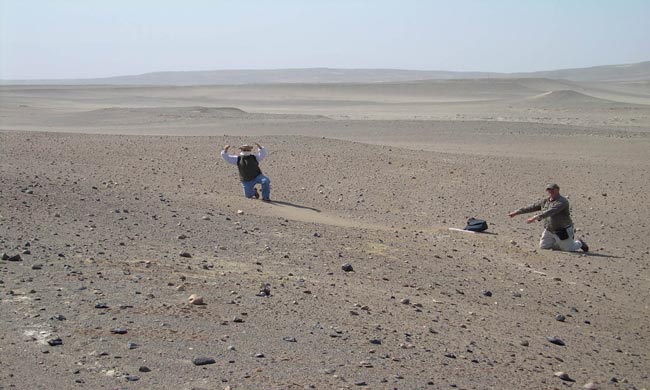Great White Sharks Once Grew Slower, Fossil Shows

Editor's Note: The story has been revised to clarify that ancient great white sharks likely grew more slowly but could have ultimately been longer, not smaller, than great whites today.
The most complete fossil of an ancient great white shark has been found in the dry deserts of Peru, including parts of the spinal column and a mouthful of 222 teeth. Great whites are the undisputed king of sharks today, with bodies that can reach more than 20 feet (6 meters) in length. But not much is known about their evolutionary history. Seems they grew a bit slower 4 million years ago. Gaps in the knowledge of shark evolution exist because fossils of shark skeletons are extremely rare finds as sharks lack the bony skeletons of other fishes - instead their skeleton is made of cartilage. Researchers stumbled upon the 4-million-year-old fossil in 1988 while examining the sediments of the Pisco Formation in the desert region of coastal, southwestern Peru. These sediments are becoming increasingly well known for a variety of fossils of whales, birds, and even an aquatic sloth, Thalassocnus. Frequently, only isolated teeth of sharks are present in ancient sediments. To get a complete picture of the fossil shark's bite, scientists have to put these isolated teeth together using information from modern sharks. Having a fossil such as the new one, with its teeth in their natural positions, is important because the shapes of particular teeth and their orientations in the jaw help determine how shark species are related to one another. "With the exceptional preservation of this Pisco Formation specimen we have a unique opportunity to advance knowledge about the ancient paleobiology of white sharks and their extinct relatives," said one of the scientists who studied the fossil, Bruce MacFadden of the Florida Museum of Natural History. Many researchers have posited that great whites descended from the all-time kings of the shark world, the so-called "megatooth" sharks. The largest of these, such as Carcharocles ("Carcharodon") megalodon were contemporaries of the Peruvian shark and may have reached lengths of 60 feet (18 meters), with a jaw gape of more than 9 feet (2.5 meters). However, the new specimen suggests that the modern great white shark is more closely related to the modern mako shark - a smaller shark that feeds mostly on fishes - than to the prehistoric giant "megatooth" sharks. "The completeness of this specimen allows us to take a closer look at the interrelationships between white and mako sharks," said Dana Ehret, a graduate student at the Florida Museum of Natural History and lead author of the study in the Journal of Vertebrate Paleontology describing the fossil. If the great white is indeed a closer cousin of the mako shark, then the modern great white and the megatooth sharks might have evolved to large size independently. The new fossil specimen was probably 17 feet (5 meters) long in life, similar in size to a large modern great white. Because this specimen also preserved part of the spinal column, scientists were able to determine that the individual was at least 20 years old when it died. The age determination was based on counting the alternating light and dark bands present in the vertebrae, which calcify with age and reflect seasonal temperature changes. A modern great white shark of similar age likely would have been larger, suggesting that this fossil species grew at a slower rate.
"There is evidence that these sharks were actually larger in the past, but just took longer to grow," Ehret told LiveScience in an email. "There are a number of factors that could have contributed to changes in growth rates, including environmental conditions and competition with other large predators."
- Vote for Your Favorite Shark
- Shark News, Images and Information
- Shark Jobs: Nature's Dirty Work
Sign up for the Live Science daily newsletter now
Get the world’s most fascinating discoveries delivered straight to your inbox.

Andrea Thompson is an associate editor at Scientific American, where she covers sustainability, energy and the environment. Prior to that, she was a senior writer covering climate science at Climate Central and a reporter and editor at Live Science, where she primarily covered Earth science and the environment. She holds a graduate degree in science health and environmental reporting from New York University, as well as a bachelor of science and and masters of science in atmospheric chemistry from the Georgia Institute of Technology.









